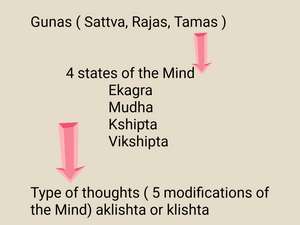Author: Randeep Singh / go to all articles on Yoga Concepts

” pramana viparyaya vikalpa nidra smrtayah “
Yoga Sutra 6 Explained:
pramana – correct or right knowledge
viparyaya – incorrect or wrong knowledge
Vikalpa – Imagination power,
-imagining things that do not exist yet
nidra – undistracted sleep
smrtayah – Impressions of the happenings of the past
In the yoga sutra prior this one Patanjali has spoken about the number and nature of the vrittis of the chitta. Here. yoga sutra 6, chapter Samadhipada, he is naming the five vrittis or modifications of the mind. Modifications mean the states, forms the mind can take. What is Mind? Mind is nothing but a collection of thoughts.
The individuals progress is determined by the nature of the thoughts the mind is made of. In case the thoughts making up the mind are of leading the individual to the higher level than before, these thoughts are termed as aklishta ( non pain causing in nature), while the thoughts which direct the individual toward pain and suffering are known as klishta thoughts.
The three gunas (sattvic, rajasic, tamasic) are responsible for different states of the mind. the states of the mind are four in number: ekagra ( one pointed state ); mudha ( inert state); kshipta ( restless state of mind); and vikshipta ( a mind which is capable of attaining occasional steadiness, is restless otherwise).
Ekagra state of mind is the result of the predominance of sattva guna which leads to akilshta thoughts causing pain in the end. Mudha state of the mind is the result of the predominance of the tamasic guna which again leads to thoughts which are klishta by nature, Kshipta and Vikshipta states of the mind are the result of the dominance of the rajasic guna majorly leading to klishta thoughts.
The thoughts so created remain colored by different feelings, and the impressions of past experiences. We normally identify our real self with the mind comprising of the thoughts colored with the feelings and experiences. This is not our real self.
The feelings and the impressions of the past experiences keep the real consciousness in a state of confusion. The whole idea of yoga is to clear this haze of any feelings and the past experiences in order to be able to realise the real consciousness hidden behind those colored thoughts.
The thoughts are like a layer of dust on the mirror, one cannot see one’s real image until the mirror is cleared of this hazy layer of dust. Removing this layer of dust – maze of colored thoughts is the main target of Patanjali’s yoga as explained in his yoga sutras.
The first step towards removing this dust of colored thoughts from the mirror of consciousness is to identify the thoughts always raiding the mind. The idea of beginning to identify the thoughts to be finally eliminated is itself overwhelming as the number of thoughts crossing a mind in a short span of time can be in millions. Patanjali has made this task easier by categorising all the possible thoughts into five categories only.
Five Modifications of the Mind – Yoga Sutra 6
These five categories are the five vrittis or modifications of the mind he is talking about in this yoga sutra. All the possible thoughts that can emerge in the Mind can be grouped in any one of these five vrittis ( modifications) based on certain commonalities between them.
The first modification is pramana or the right knowledge which the mind has gained through certain methods. The next category or the modification the thoughts within the mind take is of viparyaya or the wrong knowledge.
Thus all the knowledge that the mind holds in the form of a web of the thoughts is divided into these two categories. Other than these two the mind also stays in a state of imagination, or the presence of the thoughts of events, experiences, feelings, tensions which have not actually taken place or ever occurred yet.
This modification of the mind is named as vikalpa by Patanjali. the thoughts associated with this modification of the mind are all false and delusionary. Nidra – or the modification in which the thoughts remain in a state of inertia or suppression. This happens while one is in a state of dreamless sleep.
The mind here is in a state of non existence, thus incapable of achieving the higher states of mind. the mental faculties are at the dullest in sleep. The last modification or category of thoughts is the memory.
Memory is the collection of thoughts, flickering on the mirror of the consciousness, of the events which have happened in the past. Memories force the mind to exist in the past further dipping the clarity of the real consciousness hidden within the individual.
Patanjali says that none of these modifications the mind tends to slip into can aid in realizing the real self. All the techniques of yoga mentioned in the Yoga sutras, also the one’s devised later on are meant to be helping the practitioner to conquer these vrittis, modifications of the mind. Once the vrittis are overcome, the haze hiding the the real consciousness is removed, one can experience the real self.
Read other Informative Articles….
